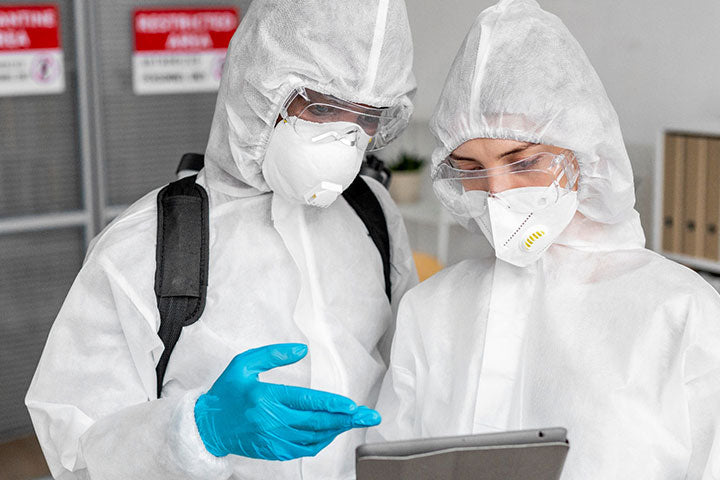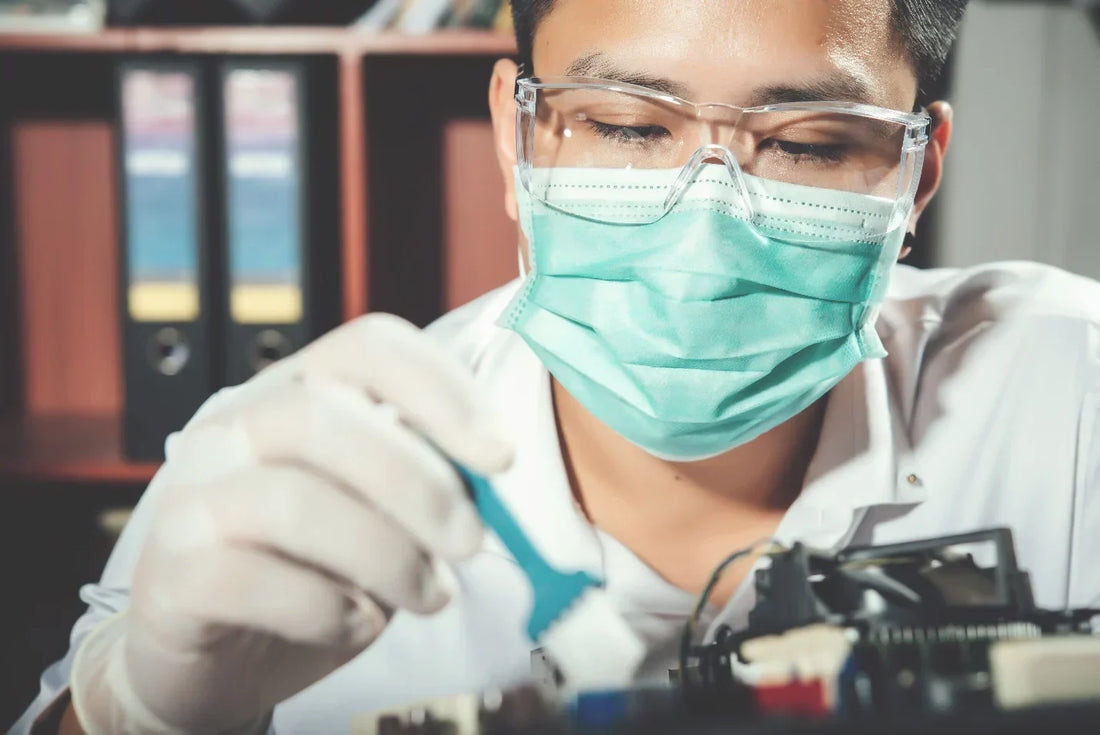Common Benchtop Biosafety Cabinet Issues & How to Fix Them Fast

Summary:
Some common benchtop biosafety cabinet issues include airflow disruptions, poor containment, alarm issues, filter failure, and noisy operation. These issues can be easily fixed with some preventive maintenance such as regular cleaning, certification, airflow tests, etc.
Introduction
Your benchtop biosafety cabinet (BSC) is the first line of defense in laboratories and healthcare facilities against the hazards of working with biological materials. This cabinet operates on the principles of controlled air flow, creating a barrier between the laboratory environment and any samples or materials that might carry biological, chemical, or other hazards.
However, like all equipment, BSCs can sometimes fail in their functions, leading to severe consequences for public, patient, and personnel safety. R&D Laboratory Equipment experts examine the common issues affecting your benchtop biological safety cabinet and their quick fixes.
Whether you are a scientist, lab manager, or research assistant, this article will help you minimize downtime, reduce repair and replacement costs, and ensure regulatory compliance.
Common Issues with Benchtop Biosafety Cabinets and Quick Fixes
Biosafety cabinets are essential for a safe and efficient laboratory process. However, lab managers and researchers should know the symptoms and dangers of BSC malfunctions.
1. Airflow Disruptions & Poor Containment
Airflow is the lifeblood of a biosafety cabinet. It ensures that contaminants are contained and the work area remains sterile. So, disruptions in the airflow can compromise the functionality of the entire cabinet, endangering laboratory personnel and research integrity. Blockage, fan issues, or incorrect sash height are the usual causes of airflow disruption.
Quick Fixes
You can reduce downtime caused by airflow disruptions by taking the following steps:
-
Check Sash Height: Ensure the sash is within the manufacturer’s recommended range. Too high or too low can affect airflow and containment.
-
Inspect the Exhaust and Intake Pipe: Ensure no blockages or equipment obstructing airflow from your cabinet.
-
Check for Fan Malfunctions: Check the fan for signs of wear or any other issue affecting its functions.
2. Contaminated Work Area
Contamination in a biosafety cabinet is a serious issue that requires quick resolution. The microbials in the cabinet can severely affect the health of lab personnel or aggravate existing patient conditions. Early identification is crucial for maintaining the integrity of lab environments, the safety of personnel, and accurate results.
Common signs of biosafety cabinet contamination include unusual odors, unexpected growth on culture plates, or visible particles in the work area. The usual suspects include poor cleaning methods and compromised HEPA filters.
Quick Fixes
-
Clean the Cabinet: Regularly wipe down the interior with an appropriate disinfectant and chemical solution to remove contaminants.
-
Check for HEPA Filter Issues: Remove and replace HEPA filters as they may have become clogged with dirt and contaminants.
-
Monitor Airflow: Ensure your equipment has free and adequate airflow and is properly calibrated.
3. Alarm and Indicator Malfunctions
Alarm systems in biosafety cabinets alert operators to potential safety hazards or performance issues. Alarm and indicator malfunctions often go unnoticed, leading to unsafe working conditions, downtime, or bad results.
Faulty wiring, sensor failures, or control system malfunctions can cause BSC alarm malfunctions.
Quick Fixes
-
Test the Alarm: Carry out periodic alarm tests to ensure they activate when necessary.
-
Check Sensor Calibration: Ensure alarm sensors are calibrated to prevent false readings.
-
Replace Faulty Components: If alarms and indicators continue to malfunction, the components may need replacement. Check with the manufacturer or your lab services provider for part specifications.
4. Filter Clogging or Failure
HEPA filters are crucial for the proper functionality of your biosafety cabinet. They trap particles and microorganisms, helping to maintain a sterile working environment. Key indicators of filter clogging and failure include decreased airflow, increased noise levels, and visible particles in the work area.
Quick Fixes
-
Inspect for Clogging: Regularly check your filter for signs of clogging, which can be caused by heavy usage or environmental factors.
-
Replace Filters: BSCs should be replaced when they reach their maximum capacity or if airflow drops below recommended levels.
5. Noisy or Unstable Operation
Unusual noises such as squeaking, squealing, loud humming, knocking, or buzzing often indicate unstable operation, internal component failure, or poor installation. These issues can lead to system breakdown, more expensive repairs, or endanger personnel if these issues are not quickly resolved.
-
Check the Fans: Inspect the fans for wear, dirt, or imbalance. Replace them if damaged, and lubricate to ensure smooth operation.
-
Ensure Proper Installation: Verify that your benchtop biological safety cabinet is installed on a level surface and all components are securely mounted.
-
Inspect for Loose Parts: Check for loose parts contributing to clanging or vibrations, and tighten or replace them as needed.
Preventative Maintenance for Benchtop Biosafety Cabinets

Proper and timely maintenance is crucial to ensure the optimal working condition of your benchtop biosafety cabinet. Some preventive maintenance tasks to ensure functionality, safety, and compliance include:
-
Clean the work surfaces and walls with an appropriate disinfectant.
-
Remove stubborn stains or spots from the worktop.
-
Test audible and visual alarms.
-
Inspect the cabinet’s mechanical and electrical systems for signs of defects or malfunctions.
-
Certification must be done annually to minimize unplanned downtime and equipment failure.
Other Maintenance Tests
-
Inflow and downflow velocity tests: Measure air movement in and out of the cabinet.
-
Particle count test: Determines air quality by counting the particles in the cabinet.
-
Filter Integrity Test: Verifies the integrity of the filter and its ability to block out contaminants.
-
Noise level test: Determines the noise level of the cabinet during normal operations.
-
UV intensity test: Determines the light intensity from the lamp from front to back of the cabinet.
Choosing the Right Biosafety Cabinet Certification Companies
Selecting the right biosafety cabinet certification companies is critical to ensuring your lab and equipment meet safety and industry standards. Here are some tips for choosing the right certification partner:
1. Accreditation and Compliance
Ensure the chosen company has the necessary biosafety cabinet certification requirements, experience, and personnel to meet all regulatory and safety standards, including NSF/ANSI 49, ISO 14644, and OSHA, NIH, and CDC requirements.
2. Certification Scope
Verify that the company provides all necessary certification and testing modules, including: HEPA filter integrity testing, inflow velocity testing, downflow velocity testing, alarm system testing and calibrations, and airflow smoke pattern tests.
3. Reputation and References
Before choosing any company for benchtop biosafety cabinet certification, ensure the contractor has a sterling reputation among similar companies in your neighborhood. Check with local associations, request references, and verify service quality from past clients.
4. Service and Support
Certification is not a one-time service. Ensure your chosen partner can offer pre-certification services such as personnel training and repair or maintenance services.
5. Compare Quotes
Before making a final decision obtain quotes from multiple companies and compare to choose the one that offers the right balance experience, expertise, and prices. Deciding based on costs alone can be a mistake as you can end up paying a low price for low-quality work and end up paying more later on repairs.
When to Seek Professional Help?
You should call in the experts for the following:
-
For Annual Certification: Most regulations require BSCs to be professionally certified at least once a year.
-
After a Major Maintenance or Relocation: Moving the cabinet disturbs airflow and filter seals. You should reschedule maintenance and recertification to ensure optimal and safe performance.
-
Alarm and Calibration Issues: The alarm system indicates compromised airflow or filter warnings. When you get an alert, stop work immediately, exit the work area, and contact a professional immediately.
-
Unusual Noises or Vibration: Loud noises while your cabinet is in operation are usually a sign of component damage or malfunction. When this happens, stop work to avoid further damage and call a professional for repair services.
-
Spills involving Hazardous Materials: A common issue with biosafety cabinets is managing hazardous spills in the work area. Biohazards and chemical spills usually require specialized cleaning. So even after taking initial steps to use an absorbent and clean up with disinfectant, you should still have a professional run a decontamination procedure for enhanced safety.
Conclusion
As a lab owner or manager, an equipment malfunction is never good. It signals expensive repairs, downtime, failed experiments, and danger to your operating license and personnel safety. Knowing the signs of benchtop biosafety cabinet malfunction and how to fix them can help reduce downtime, repair costs, ensure equipment longevity, and maintain compliance.
Common problems you should watch out for include noisy operation, contaminated areas, alarm malfunctions, etc. Some of these issues require more extensive and professional attention. R&D Laboratory Equipment experts meet global biosafety cabinet certification requirements and can help your equipment function safely and efficiently.
FAQs
1. How to troubleshoot a biosafety cabinet?
Key steps to troubleshoot a BSC include checking the alarm system, inspecting HEPA filters, cleaning the work surface, testing airflow, and verifying certification. If you can’t find the problem, call a professional for help.
2. How to maintain a biosafety cabinet?
Maintaining a biosafety cabinet involves regular cleaning, disinfection, and proper airflow checks to ensure optimal performance.
3. What are the best practices for biosafety cabinets?
Ensure proper airflow, separate clean and dirty items in the cabinet, keep intake air grills clear, and ensure regular cleaning of HEPA filters and the work area.
4. How do you calibrate a biosafety cabinet?
Testing procedures for biosafety cabinets include measuring airflow to prevent contamination. There will also be tests to visualize air patterns to confirm the absence of turbulence and maintain a sterile environment.
5. How should you handle a small spill in the biosafety cabinet?
Immediately contain the spill with absorbent materials such as paper towels and apply disinfectants.
6. What is the lifespan of a biosafety cabinet?
Modern biosafety cabinets have a lifespan of 15 years.
7. What is the most common biosafety cabinet?
A class II, Type A2 biosafety cabinet is the most common type used in laboratories today.
8. How long should the biosafety cabinet be allowed to run before beginning work?
Allow cabinet blowers to operate for 3-5 minutes before beginning work to allow the equipment to get rid of particles on the work surface.
9. How to clean a BSC hood?
Wipe down the entire hood with a 1:10 bleach or any other appropriate disinfectant.
10. What disinfectant is used in biosafety cabinets?
To prevent corrosion, use a squeeze bottle of 10% bleach and follow it with a 70% ethanol rinse.






